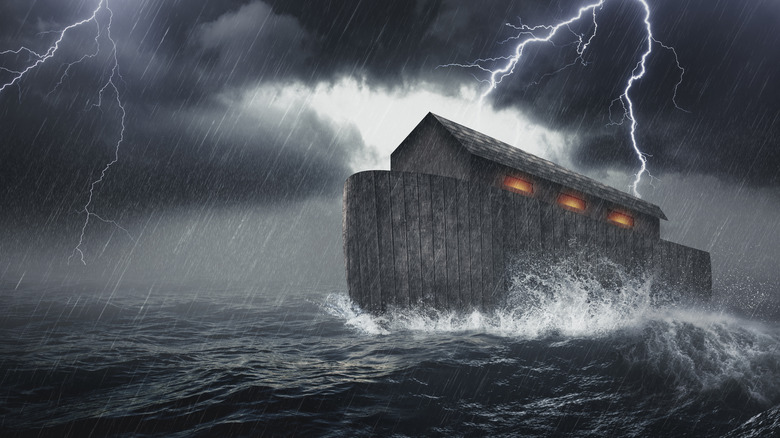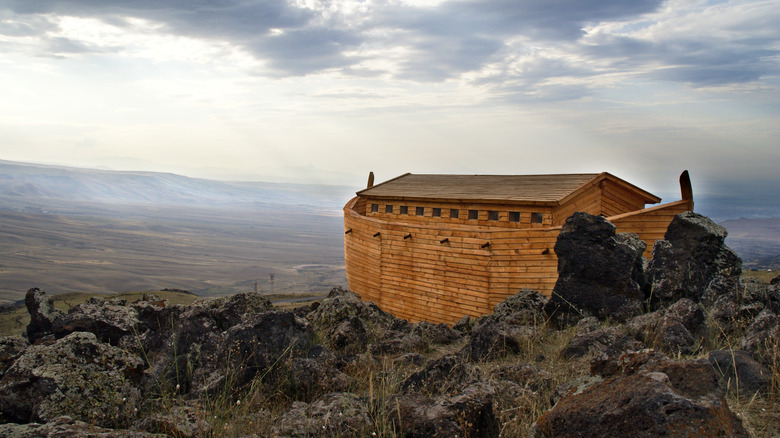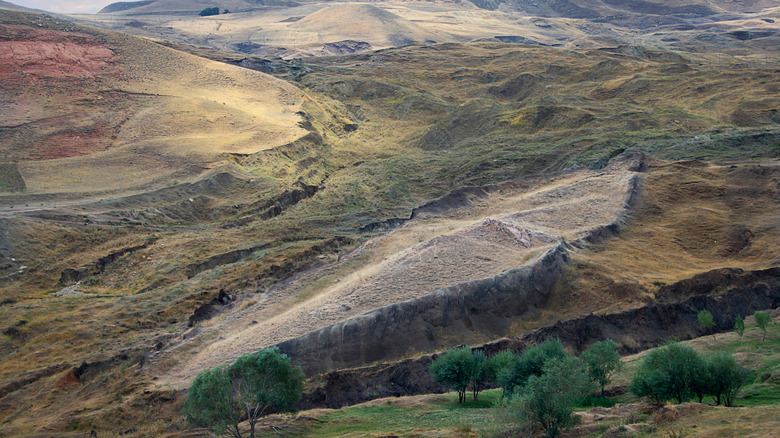Is There Any Physical Evidence That Noah's Ark Existed?
The story of Noah's Ark and the flood that destroyed the world is one of the most famous stories from the Bible. According to the Book of Genesis, God — who thought humanity had become so wicked that he had no choice but to wipe them all out and start over — tells Noah to build a giant boat and get his family and plenty of animals on board before he sends the killing flood his way.
Noah's ark story is not exclusive to the Bible, however. The Quran has a similar story in it, where Nuh (Noah) also builds a boat while trying to warn people of the imminent flood if they don't repent. According to both books, not a single person managed to stop being wicked on time — except for Noah and his close family, nobody else survived the flood once it came.
The flood narrative has fascinated researchers for centuries, and plenty of believers have looked for the ark — without much luck — over the years. To scientists, searching for the ark is akin to searching for Bigfoot or the Loch Ness monster — a fascinating idea, maybe, but also not one likely to be real.
Aside from faith, is there anything else backing the idea that an ark even exists?
Noah's Flood could have happened
Was there ever a flood that destroyed most of the world? According to the Bible, Noah's flood was a global flood. It covered even the highest mountains on Earth (so Everest would've been underwater) with rains that lasted for 40 days. It took an additional 110 days before the waters receded enough that the ark reached land, which happened to be the mountains of Ararat. Still, the land was so wet (and presumably so muddy and slippery) that both humans and animals had to remain in the ark for "a year plus two months and twenty-seven days" waiting for things to dry up (via National Center for Science Education).
That's a lot of water for a long time, and a flood like that would've left plenty of scientific evidence behind. For example, NCSC points out that sedimentary rocks containing fossils around the world often also contain materials that can only form when exposed to oxygen in open air. Meaning, these fossilized rocks couldn't have occurred underwater. Plus, vanishing civilizations around the world would've left some kind of archeological footprint behind: remnants of buildings, bodies, artifacts. Still, nothing has ever been found.
It is possible, however, that a local (but massive) flood did take place in southeastern Mesopotamia in ancient times. With enough rain falling on the mountains around, the plains of the Tigris and Euphrates Rivers could experience flooding of Biblical proportions —just a very localized one.
The impossibility of the ark
The Bible gives specific instructions regarding the construction of the ark using cubit measurements (one cubit is around 18-22 inches). Using the smaller number (18), the ark is supposed to be 300 cubits long, 50 cubits wide, and 30 cubits high. That translates to a size in feet of 450 x 75 x 45 (via The Guardian). This would make the ark almost half the size of the Titanic, which was 850 feet long. It was also about one and a half football fields long, the length of three NASA space shuttles lined up nose to tail, or the size of three Olympic size swimming pools (per Answers in Genesis).
So how exactly did Noah manage to build a boat of that size with the materials and tools available at the time? According to the National Center for Science Education, Noah would have needed extensive knowledge of naval architecture, physics, calculus, and mechanics, as well as access to very specific materials to keep the hull watertight. It would also be almost impossible to harvest so much timber in a short period of time.
Then imagine being able to carry enough bamboo for the pandas, fresh fish for the penguins, and piles and piles of roots and grasses for the elephants. Then there's the need to separate predators, make space for animals with horns (like rhinos that could destroy the hull if left to roam), and keep anything venomous contained. In short, the construction of a viable ark sounds pretty impossible.
Searching for the remains of Noah's ark
In 1876, historian and politician James Bryce climbed Ararat and claimed to have found "a piece of wood about four feet long and five inches thick, evidently cut by some tool, and so far above the limit of trees that it could by no possibility be a natural fragment of one" (as quoted in the book The Quest for Noah's Ark).
Official searches started in the 1940s with no results. Then in 1973, author Violet M. Cummings declared in her book "Noah's Ark: Fable or Fact?" that the ark had been found on Mount Ararat (it had not), and in 1993, CBS interviewed somebody who claimed to have seen the ark (turns out he hadn't). By 2006, intelligence-gathering satellites were taking photographs of a geological anomaly on Mt. Ararat that (sort of) resembled the shape of the ark. That wasn't it either (via Live Science).
In 2012, "Baywatch" star Donna D'Errico joined a documentary film crew in search for the ark. She quit along the way, citing fears for her safety. The crew didn't find the ark either (as reported by Live Science).
The search for the ark became so popular that a new word was coined along the way. For creationists, Arkeology (the historical search for the ark) represents a lot more than searching for a boat — if Noah's ark is found, this would mean the story of the flood and the creation narrative are more than a myth (per NSCE).
The possible Noah's Ark evidence hoax
Perhaps the most significant claim is the one from 2010, when a group of evangelical explorers and filmmakers associated with Noah's Ark Ministries International (NAMI) claimed to be "99.9%" sure they had found the ark on Ararat. They had plenty of ways to prove this, such as results of carbon dating the wood — it was 4,800 years old and high up on a mountain with no trees, so it couldn't be anything but the ark. They also claimed to have walked into the ark-like structure and seen compartments or rooms, lots of plank-like timber, and wood fragments (per Fox News).
But rumors started circulating soon after about the discovery being a hoax. One of the archeologists in the original expedition claimed the wooden beams had been planted on Ararat. Even the pro-ark Institute for Creation Research reported the location looked too much like a movie set rather than historical remains. Plus the wooden pieces found seemed "too well-preserved," the ark looked too small, and some local Kurdish men claimed to have been hired to haul the wood up the mountain. The whole "project" took over two years, during which time several expeditions from NAMI visited the sites, took suspiciously blurry photos, and gathered "proof" that they would then reveal in 2010 (via Christian Science Monitor).
Plagued by accusations of organizing a hoax, NAMI has refused to reveal the location of the "ark" until more evidence could be gathered. The group has been quiet about the whole thing for over a decade.




